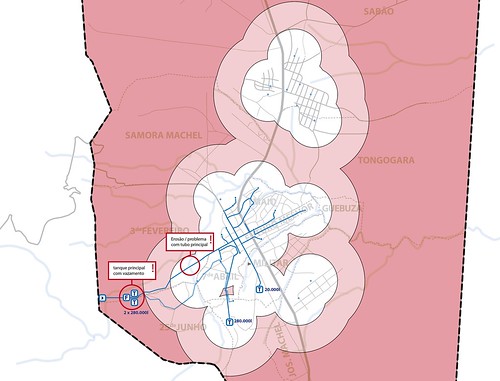
General
„What public service is the most important one?“ This question asked to the urban population in the remote often informally grown districts of the city is usually answered very clearly: It is a working supply with clean water, which is required by most. And this request is consistent with the recommendations from a technical point of view: access to clean water is the key factor to avoid many other problems in urban informal settlements.
Two systems
For the inventory of todays technical facilities of the municipal water supply it has to be distinguished between the reticulated water supply by pipes with a central supply (in the area of the inner city) and the numerous manual hand pumps and remote terminal units on the outskirts of the city. In general these two systems, piping system and remote terminal units form in many Mozambican small- and medium-sized cities, the total public water supply system.
Pipe system
Most of the existing pipe systems are powered from a higher located central supply point, with a filter and a tank system. On the removal side public access points are available in central locations of the communities. From these points, the supply is done by private persons to the private land and houses. There are also celestial public outlets, from which the water is being carried to the households by buckets or canisters.
Decentralized pumps
At the decentralized water withdrawal points, the water from deeper soil layers is being pumped to the surface by machine or hand operated pumps. The transport to the households is again done by canisters or buckets.
Inventory of all devices / catchment areas
In addition to the registration of all devices as described above it seems also useful to visualize the distances and the population densities in relation to the respective outlets. Thus, it is easy to identify in which areas of the city water supply is critical and therefore where action is needed.
Maps and Graphics: Georg Jahnsen in collaboration with the two Municipalities of Catandica and Manica, Mozambique.

Allgemein
Die Frage nach der wichtigsten städtischen Dienstleistung beantwortet die Bevölkerung in den von den Stadtzentren weiter entfernt liegenden meist informell entstandenen Stadtvierteln fast einstimmig. Es ist eine funktionierende Versorgung mit sauberem Wasser, die von den meisten gefordert wird. Und dieser Wunsch deckt sich mit den Einschätzungen und Empfehlungen aus fachlicher Sicht: der Zugang zu sauberem Wasser ist der Schlüsselfaktor zur Vermeidung zahlreicher weiterer Probleme in informellen städtischen Siedlungen.
Für die Erhebung der heutigen Anlagen und Einrichtungen der städtischen Wasserversorgung muss zunächst unterschieden werden zwischen der netzartigen Wasserversorgung über Rohre mit zentraler Einspeisung (Bereich der Innenstadt) und den meist zahlreichen manuellen Handpumpen und dezentralen Entnahmestellen in den Aussenbezirken der Stadt. In der Regel sind es diese beiden Strukturen, Rohrsystem und dezentrale Entnahmestellen, die in vielen mosambikanischen klein- und mittelgrossen Städten das öffentliche System der Wasserversorgung bilden.
Rohrsystem
Meist werden die vorhandenen Rohrsysteme über eine erhöht gelegene zentrale Einspeisung, die ein Filter- und Tanksystem beinhaltet mit Frischwasser versorgt. Auf der Entnahmeseite stellen die Gemeinden in der Regel an zentralen Stellen öffentliche Anschlusspunkte zur Verfügung. Von dort erfolgt die Herstellung einer Zuleitung zu den Grundstücken und Häusern privat. Ausserdem gibt es überirdische öffentliche Entnahmestellen, von denen der Wassertransport zu den Haushalten per Eimer oder Kanister erfolgt.
Dezentrale Entnahmestellen
An den dezentralen Wasserentnahmepunkten stellt die Stadt eine von Maschine oder Hand betriebene Pumpe bereit, mit deren Hilfe Wasser aus tiefer gelegenen Erdschichten an die Oberfläche gepumpt werden kann. Der Transport in die Haushalte erfolgt wiederum per Kanister oder Eimer.
Erfassung der Technik / Einzugsgebiete
Neben der örtlichen Erfassung aller oben beschriebenen Einrichtungen scheint darüber hinaus eine Visualisierung der Distanzen und der Bevölkerungsdichten in Bezug zu den jeweiligen Entnahmestellen sinnvoll. So lässt sich einfach erkennen, in welchen Stadtbereichen die Wasserversorgung kritisch ist und wo demnach Handlungsbedarf besteht.
Karten und Grafiken: Georg Jahnsen in Zusammenarbeit mit den beiden Munizipien Catandica und Manica in Mosambik.
Geral
A pergunta "O que serviço urbano e mais importante?" respondeu a população nos bairros informais mais distantes do centro urbano, quase por unanimidade. A abastecimento úteis de água potável é exigido pela maioria. Este pedido é compatível com as avaliações e as recomendações de um ponto de vista técnico e profissional: o acesso à água limpa é o factor chave para evitar muitos outros problemas em assentamentos urbanos informais.
Dois sistemas
A recolha dos meios técnicos do abastecimento de água municipal de hoje deve primeiro distinguir entre o abastecimento reticulada com uma alimentação central (na área central da cidade) e, geralmente, muitas bombas manuais na periferia da cidade. Em geral, são esses dois sistemas, sistema de tubulação e biombas manuais, que constituem em muitos cidades moçambicanos pequenas e médias, o sistema total de abastecimento público de água.
Sistema de tubulação
A maioria dos sistemas de tubulação existentes são alimentados por uma entrada central de água fresca num lugar alto. Esta entrada inclui um sistema de filtros e um tanque grande. A otro lado do sistema os municípios fornecem pontos de conexão públicos. De lá, a produção dum alimento para os terrenos e as casas é privado. Há também torneiras públicas, do que o transporte de água e feito com baldes ou latas.
Bombas descentrais
Nos pontos de abastecimento de água descentralizada, a cidade disponive uma bomba (máquina ou manual) para bombear água das camadas mais profundas do solo para a superfície. O transporte nos domicílios é novamente feito com balde ou lata.
Captação da técnica / áreas de fornecimento
Além da captação de todos os dispositivos descritos também faz sentido de visualizar as distâncias e as densidades de população em relação a os pontos de fornecimento. Assim, vai ser fácil de ver em que áreas o abastecimento de água da cidade é crítica e onde é necessário para intervir no futuro.
Mapas e Gráfica: Georg Jahnsen em collaboração com os Municípios de Catandica e Manica, Moçambique